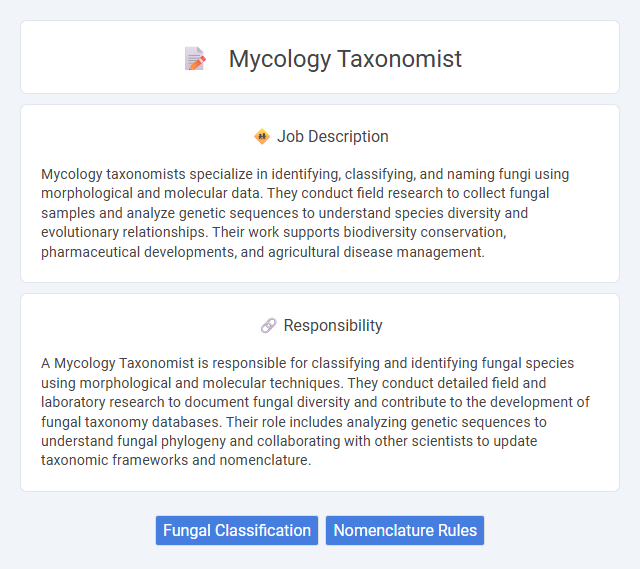
Mycology taxonomists specialize in identifying, classifying, and naming fungi using morphological and molecular data. They conduct field research to collect fungal samples and analyze genetic sequences to understand species diversity and evolutionary relationships. Their work supports biodiversity conservation, pharmaceutical developments, and agricultural disease management.
Individuals with a keen interest in fungi and strong analytical skills are likely to be well-suited for a mycology taxonomist role. Those who enjoy detailed research, classification, and fieldwork may find this career fulfilling. Conversely, people who prefer fast-paced or highly social environments might find it challenging to adapt to the meticulous and often solitary nature of taxonomic work.
Qualification
A Mycology Taxonomist requires a strong foundation in biological sciences, particularly in mycology, microbiology, or botany, often supported by a bachelor's or master's degree in these fields. Proficiency in molecular techniques, fungal identification, and taxonomy classification systems is essential for accurate species identification and research. Experience with bioinformatics tools, phylogenetic analysis, and taxonomic databases enhances a candidate's ability to contribute to scientific studies and environmental monitoring.
Responsibility
A Mycology Taxonomist is responsible for classifying and identifying fungal species using morphological and molecular techniques. They conduct detailed field and laboratory research to document fungal diversity and contribute to the development of fungal taxonomy databases. Their role includes analyzing genetic sequences to understand fungal phylogeny and collaborating with other scientists to update taxonomic frameworks and nomenclature.
Benefit
A Mycology Taxonomist likely experiences considerable benefits from their work, including opportunities to contribute to biodiversity conservation and fungal classification advancements. The role may provide access to cutting-edge research tools and collaborations with academic and environmental organizations. Job satisfaction probably stems from the potential to impact agriculture, medicine, and ecology through detailed fungal identification and taxonomy.
Challenge
Mycology taxonomists likely encounter challenges in accurately identifying and classifying fungi due to their vast diversity and the complexity of fungal genetics. The evolving nature of fungal taxonomy may require continuous learning and adaptation to new molecular techniques and phylogenetic tools. Navigating limited resources and sometimes ambiguous morphological characteristics could further complicate precise species delineation.
Career Advancement
A mycology taxonomist specializing in fungal classification and biodiversity may advance their career by engaging in molecular phylogenetics research, expanding expertise in fungal genomics, and publishing peer-reviewed studies in leading scientific journals. Opportunities for progression include leadership roles in academic research institutions, consulting for biotechnology firms, or contributing to environmental and agricultural policy development. Developing proficiency in bioinformatics tools and securing grants for mycological research further enhance career growth prospects.
Key Terms
Fungal Classification
A Mycology Taxonomist specializes in fungal classification, utilizing morphological characteristics and molecular data to identify and categorize fungal species. They analyze genetic sequences, such as ITS regions, to construct phylogenetic trees that reveal evolutionary relationships within fungi. Accurate fungal taxonomy supports ecological studies, biodiversity assessments, and advances in biotechnology by clarifying species boundaries and nomenclature.
Nomenclature Rules
Mycology taxonomists specialize in classifying fungi according to the International Code of Nomenclature for algae, fungi, and plants (ICNafp), ensuring accurate and consistent naming conventions. They apply nomenclature rules to assign valid scientific names, resolve synonyms, and update taxonomic revisions based on molecular phylogenetics. Mastery of Latin binomials, type specimens, and priority principles helps maintain global standardization in fungal taxonomy.
 kuljobs.com
kuljobs.com